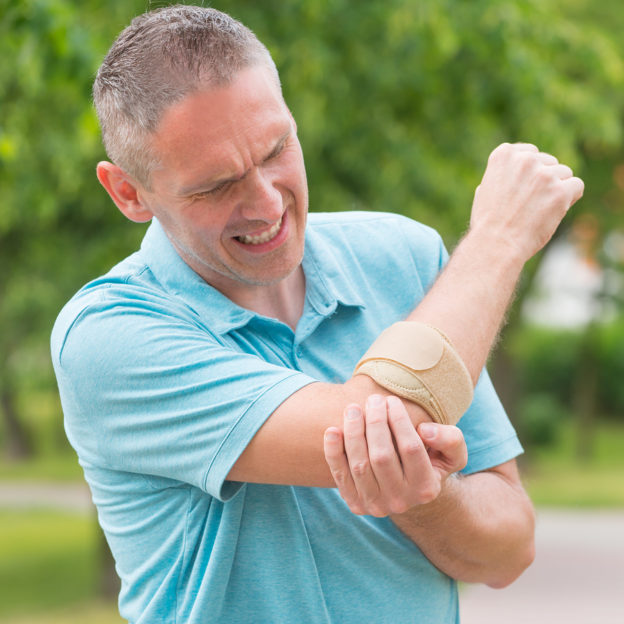By David Blyweiss, M.D., Advanced Natural Wellness
June 14, 2017
- A painful elbow doesn’t necessarily mean you have “tennis elbow”
- How to identify repetitive strain injuries
- When your funny bone isn’t so funny
When people come into my office with unexplained aches, pains or numbness in one elbow or another, they often describe their condition as “tennis elbow”.
And in many cases, they’ve looked this term up on the internet to set their own treatment schedule, only to find that it’s not working.
The reason is pretty simple. Not all aches and pains of the elbow are the same. So if you’re treating yourself for tennis elbow, you may be aggravating another condition that’s causing your elbow pain.
With this in mind, let’s take a look at some things that could be at the source of your elbow pain.
Open your arteries, improve blood flow for a new health miracle...
Did you know your circulatory system has over 60,000 miles of arteries, veins and other blood vessels, if stretched end to end?
But as you age, your blood vessels undergo changes, which may cause them to stiffen, thicken and get clogged.
GOOD NEWS! Doctors have now identified a “Miracle Molecule” inside your arteries that helps OPEN your arteries and IMPROVE blood flow.
It’s what Dr. Valentin Fuster calls it, "One of the most important discoveries in the history of cardiovascular medicine."To you, that means...
- Healthy blood pressure
- Sharper mind and memory
- Skyrocketing energy and muscular strength
- Increased pleasure and passion in the bedroom
- Improved circulation to every cell and organ in your body
Go here to discover a new natural way to significantly boost the levels of this miracle molecule in YOUR body NOW!
How to Identify Repetitive Strain Injuries
Tennis elbow is tendon inflammation on the outside of the elbow caused by repetitious movements. An easy way to identify it is to place your palm on your stomach. This will place your elbow at about a 90 degree angle. The inflamed area will be the bony part at the outside of the elbow.
Golfers elbow is also a repetitive strain injury. The difference is that the pain, tenderness and inflammation are on the inner side of your elbow. The pain may also run down the inside of your forearm… the side that your pinky finger is on.
Both of these are caused by arm and wrist movements you make over and over again – from something as simple as the repetitive use of a screwdriver or scanning groceries to more intense activities like raking and painting.
The World's Quickest Solution for Ending Prostate and Urinary Misery
This has recently been revealed to be one of the only real breakthroughs in prostate health.
The seeds of a strange fruit (sometimes called "Chinese Apples") hold powerful phytonutrients that are a revolution in prostate health.
In fact, UCLA and Veterans Administration research have now proved this to be true.
Not only that, but it may be the worlds quickest solution for ending prostate misery.
Simply stated, these phytonutrients represent a huge step beyond beta sitosterol, saw palmetto, and other phytosterols alone.
Simply click HERE if you want to have fast prostate relief...restful, uninterrupted sleep...no more constant "urges to go"...enhanced virility...and optimal prostate support for life.
Clearly, the first recommendation is to avoid those activities that are causing the problem. But that’s not always possible. In that case, it’s a good idea to use an elbow strap to prevent further strain and injury.
You can also alternate heat and ice for 15 to 20 minutes at a time, three to four times a day. (Just make sure to wrap your ice pack in a thin towel to prevent skin damage.)
There are also a couple of exercises you can try.
For tennis elbow, you need extension exercises. For example, hold the affected arm straight out in front of you, palm facing the floor. Then, bend your hand at the wrist so your fingers all point to the ground. Place the palm of your other hand against the back of the affected hand and press it toward you. Hold the position for 30 seconds. Repeat three times.
Golfer’s elbow, on the other hand, needs flexion exercises. So you’ll do just the opposite. Hold your affected arm in front of you with the palm to the floor. Then, bend your hand at the wrist so all your fingers point toward the ceiling. Place your other hand in the center of the affected palm and press it toward you. Hold the position for 30 seconds. Repeat three times.
Doc, My Funny Bone Hurts
Cubital tunnel syndrome is another cause of elbow pain. It occurs when you constantly hold your elbow in a flexed position of 90 degrees or more. This constant strain compresses the ulnar nerve that runs through your elbow.
It resembles the zing you get when you hit your “funny bone”, but it’s more consistent. (We actually don’t have a funny bone… what we’re really hitting is this nerve.) When this nerve is constantly compressed, it causes pain, numbness and tingling that can radiate all the way down into your pinky and ring fingers.
Simple things like driving with your elbow propped on the window or console can set it off. Typing on a computer keyboard with your elbows flexed for long periods of time or leaning your elbows on your desk regularly can bring it on, too. Even sleep can aggravate it, especially if you sleep with your arms bent.
During the day, I recommend wearing a padded elbow brace. This helps keep your elbow at a straighter angle and reminds you not to lean on it. (If you do occasionally lean on it, the padding helps reduce nerve compression.)
Then, when you’re ready for bed, remove the brace and wrap a towel around your elbow to keep it straight while sleeping.
Bursitis is also caused by leaning on your elbow for long periods of time. This irritates the bursa sacs that cushion and lubricate the bony tip of your elbow. But unlike cubital tunnel syndrome, swelling is often the first symptom. This swelling causes the bursa to stretch and become painful.
Ice and heat, elbow pads and resisting the urge to rest your elbow on hard surfaces can all help speed up your recovery.
However, I do have a word of caution when it comes to bursitis. If your elbow becomes hot, red and painful, it may be caused by an infection in the bursa sacs. In this case, it’s very important that you seek immediate medical attention.







